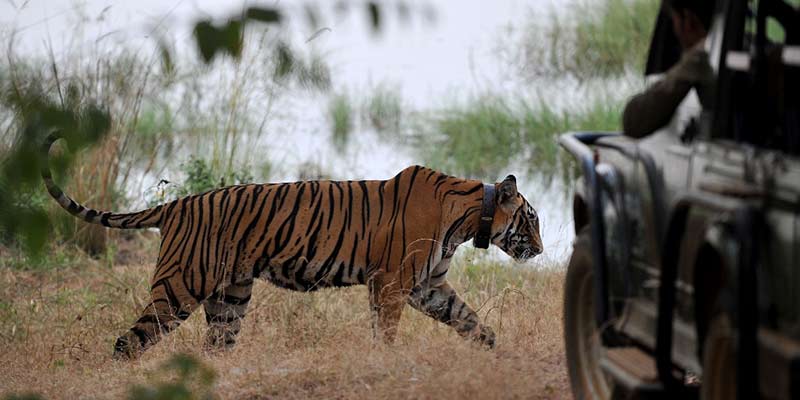- India
- Jul 29
India home to 75% of the world’s tiger population
• International Tiger Day is celebrated on July 29 to turn the spotlight on the conservation of tigers worldwide.
• International Tiger Day was first celebrated following the Saint Petersburg Tiger Summit in Russia in 2010.
• Tigers have been on the brink of extinction for the past few decades. Many factors have caused their numbers to fall, including habitat loss, climate change, hunting, and poaching.
• International Tiger Day aims to bring attention to this fact and try to halt as well as reverse its decline. The objective is to protect and expand their habitats and raise awareness of the need for conservation.
Rise in tiger population in India
• India is home to 75 per cent of the world’s tiger population.
• According to the latest tiger census data, the tiger population in the country increased from 2,967 in 2018 to 3,167 in 2022.
• The tiger population has gone up in the Shivalik Hills-Gangetic Plains landscape, central India and the Sundarbans, but their numbers have dwindled in the Western Ghats and the Northeast-Brahmaputra Plains due to habitat loss, fragmentation and poaching over the years.
50 years of Project Tiger
• In 1973, the Project Tiger was established with the objective of utilising the tiger’s functional role and charisma to garner public support and resources for preserving representative ecosystems.
• Project Tiger is an ongoing centrally sponsored scheme of the ministry of environment, forests and climate change providing central assistance to the tiger states for tiger conservation in designated tiger reserves.
• Since its inception, the project has expanded from nine tiger reserves covering 18,278 square kilometres (sqkm) to 53 reserves in 18 tiger range states covering 75,796 sqkm, which account for 2.3 per cent of India’s land area.
• The tiger reserves are constituted on a core/buffer strategy. The core areas have the legal status of a national park or a sanctuary, whereas the buffer or peripheral areas are a mix of forest and non-forest land, managed as a multiple use area.
• Most tiger reserves and protected areas in India are existing as small islands in a vast sea of ecologically unsustainable land use, and many tiger populations are confined to small protected areas.
• Although some habitat corridors exist that allow tiger movement between them, most of these habitats are not protected areas, continue to deteriorate further due to unsustainable human use and developmental projects, and thereby are not conducive to animal movement.
• Project Tiger aims to foster an exclusive tiger agenda in the core areas of tiger reserves, with an inclusive people oriented agenda in the buffer.
• The conservation of tigers in India can be divided into two phases. The first phase starting in the 1970s, involved the enactment of the Wildlife Protection Act and the establishment of protected areas that helped conserve tigers and tropical forest ecosystems.
• However, in the 1980s, the trade in tiger parts began to decimate the population, leading to a shocking revelation of local extinction of Tigers in the Sariska Tiger Reserve in 2005 and thus began the second phase.
• The second phase began in 2005-06, with the government adopting a landscape-level approach and implementing strict monitoring for tiger conservation.
• This resulted in an increase in the tiger population.
• The National Tiger Conservation Authority (NTCA) is a statutory body of the ministry, with an overarching supervisory / coordination role, performing functions as provided in the Wildlife (Protection) Act, 1972.
Challenges for tiger conservation
• Despite efforts to conserve tigers, there are still several challenges that need to be addressed.
• One of the major challenges is aligning the aspirations of large-scale economic development while safeguarding forests and their wildlife and mitigating human-tiger conflict.
• Other silent and surmounting threats are climate change-related impacts on habitats and the loss of the quality of forests over time.
• Out of the approximately 400,000 sqkm of forests in tiger states, only one-third are in relatively healthier condition.
• Another significant challenge is the illegal wildlife trade. Even though poaching is illegal, the demand for tiger products remains high, and poachers continue to kill tigers for profit.
• To combat this, the Indian government has implemented strict laws and increased surveillance to prevent poaching and illegal trade.
• To ensure the long-term survival of tigers in India, a multi-faceted approach is needed, including protecting and expanding tiger habitats, preserving population connectivity, minimising human-tiger conflicts, and combating threats like habitat loss, poaching, and illegal trade.
• It is important to restore habitats, increase ungulate populations, and plan reintroduction of tigers in low density areas to tackle conflict issues.
• The involvement of various stakeholders, such as governments, NGOs, local communities, and businesses, is crucial.
• Strategies like increased patrolling, monitoring, and law enforcement, focus on “Other Effective Area-based Conservation Measures (OECM)” along with promoting eco-tourism and sustainable livelihoods for local communities, can help achieve this goal.
Manorama Yearbook app is now available on Google Play Store and iOS App Store


